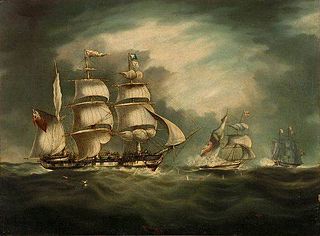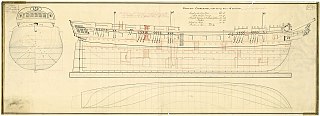
HMS Egmont was a 74-gun third rate ship of the line of the Royal Navy, launched on 7 March 1810 at Northfleet.

HMS Belle Poule was a Royal Navy fifth-rate frigate, formerly Belle Poule, a Virginie-class frigate of the French Navy that had been built by the Crucy family's shipyard at Basse-Indre to a design by Jacques-Noël Sané. She was launched on 17 April 1802, and saw active service in the East. In 1806 a British squadron under Sir John Borlase Warren captured her off La Palma in the Canary Islands. The Admiralty commissioned her into the Royal Navy as HMS Belle Poule. She was sold in 1816.

HMS Porcupine was a Royal Navy Banterer-class post ship of 24 guns, launched in 1807. She served extensively and relatively independently in the Adriatic and the Western Mediterranean during the Napoleonic Wars, with her boats performing many cutting out expeditions, one of which earned for her crew the Naval General Service Medal. She was sold for breaking up in 1816 but instead became the mercantile Windsor Castle. She was finally sold for breaking up in 1826 at Mauritius.

HMS Weazel was a Royal Navy 18-gun Cruizer-class brig-sloop, launched in 1805 at Topsham, Devon. She saw active service in and around the Mediterranean during the Napoleonic Wars resulting in her crews earning three clasps to the Naval General Service Medal, was decommissioned in 1815, and was sold for breaking in 1825.

HMS Racehorse was a Royal Navy 18-gun Cruizer-class brig-sloop built by Hamilton & Breeds and launched in 1806 at Hastings. She served in the English Channel, where she captured a small privateer, and in the East Indies, where she participated in the capture of Isle de France and the operations around it. She was wrecked in 1822.
HMS Mullett was a Royal Navy Ballahoo-class schooner of four 12-pounder carronades and a crew of 20. The prime contractor for the vessel was Goodrich & Co., in Bermuda, and she was launched in 1807. Mullett had an apparently useful and completely uneventful career until she was sold at the end of 1814.
HMS Colibri was the French naval Curieux-class brig Colibri, launched in 1808, that the British captured in 1809 and took into the Royal Navy under her existing name. She spent her time in British service on the North American station based in Halifax, Nova Scotia. During the War of 1812, Colibri served mostly in blockading the American coast and capturing privateers and merchant ships. She foundered in 1813 in Port Royal Sound, South Carolina, but without loss of life.

HMS Lightning was launched in 1806 as a Thais-class fireship. Like the other members of her class she was quickly converted to a sloop. She participated in the second Battle of Copenhagen, captured a number of small prizes, and was sold in 1816.
HMS Patriot was a Dutch schuyt that the Royal Navy captured in 1808 and took into service. She captured several enemy vessels before she was converted to a water vessel in 1813. The Admiralty sold her in 1815.

Junon was a 40-gun Minerve-class frigate of the French Navy.

HMS Podargus was a Crocus-class brig-sloop of the Royal Navy. She participated in one major battle during the Gunboat War between Britain and Denmark. After the war she served at Saint Helena for five or six years. On her return to Britain in 1820 she was laid up; she was finally sold in 1833.
HMS Gleaner was the mercantile ketch Gleaner, launched in 1802. She served the Royal Navy as the "hired ketch Gleaner" from 12 July 1808 until the Navy purchased her in 1809. Initially she served as a light vessel and survey vessel. From early 1811 to August 1811 she served in the Mediterranean, where she captured an Ottoman vessel. She then became a yard lighter and a light vessel again. Then in 1812 she was on the North American station where she participated in the capture of several merchant vessels. Next she returned to the Mediterranean where she captured a privateer. Finally, she served off the north coast of Spain where she was wrecked on 2 March 1814.
HMS Challenger was a Cruizer-class brig-sloop launched at Redbridge, Southampton, in 1813. She participated in the capture of a French privateer and then sailed to the East Indies. She was laid up in 1819 and sold in 1824.

HMS Wanderer was a Cormorant-class ship-sloop launched in 1806 for the Royal Navy. The Royal Navy sold her in 1817. She made one voyage between 1817 and 1820 as a whaler in the British southern whale fishery. She then sailed between Plymouth and North America until October 1827 when her crew had to abandon her at sea because she was waterlogged.
HMS Muros was launched at Chatham Dockyard in 1809. She had a relatively uneventful career though she did participate in one major campaign. She was sold in 1822 for breaking up.
HMS Nimble was a new cutter that the Royal Navy purchased in 1813. The Navy sold her in 1816.
HMS Woodlark was launched in 1808 and commissioned in 1809. The Royal Navy sold her in 1818. She then became a merchantman with her new owners retaining her name. From 1820/1821 she became a whaler, sailing out of Port Jackson. She was still sailing as late as the late 1850s.
HMS Tweed was launched in 1807. On the Jamaica station she captured two small privateers and several merchant vessels. On the North Sea station she captured one small privateers and several merchant vessels. She was wrecked on 5 November 1813 with the loss of more than half her crew.
HMS Pioneer was a Pigmy–class schooner of the Royal Navy, launched in 1810 as a cutter. During her service with the Navy she captured one French privateer and assisted at the capture of another. In 1823–1824 she underwent fitting for the Coast Guard blockade. She then served with the Coast Guard to 1845. She was sold at Plymouth in 1849.
HMS Lyra was a Cherokee-class brig-sloop launched at Deptford in 1808 for the Royal Navy. In 1809 she was one of the vessels that participated in the Battle of Basque Roads. Thereafter, she captured numerous small prizes. Between 1812 and 1814 she served off the Spanish coast. In 1816 Lyra sailed to China as escort to a diplomatic mission. The Navy sold her in 1818. She then became a whaler. Between 1819 and 1833 she made five voyages in the southern whale fishery. She was last listed in 1833.








